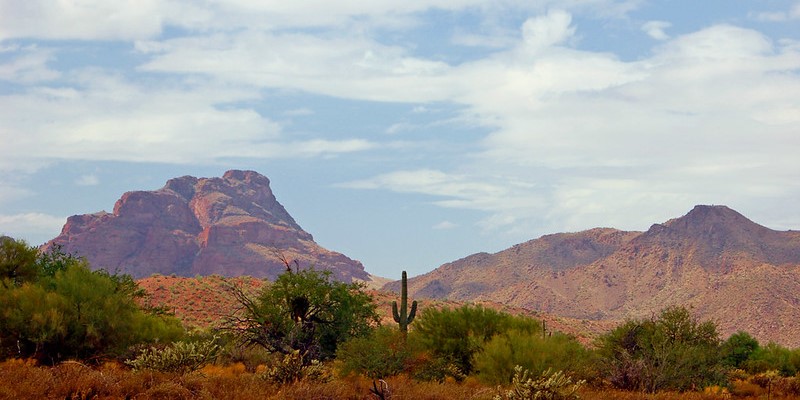By Sarah Betz.
A Sacred Site Since Time Immemorial
Oak Flat, located in Arizona’s Tonto National Forest, is a sacred site for many Native American tribes in Arizona. The site has been the epicenter of Western Apache life and spiritual activity since before recorded history, with some comparing its religious significance to that of Mount Sinai or St. Peter’s Basilica. Now, the federal government is allowing a mining company to destroy this sacred site. In March, the Ninth Circuit Court of Appeals will hear what is “probably the most important Native American religious liberty case in 15 years.”
The Backdoor Deal
In the 1870s, the United States government forcibly removed the Apache people from their ancestral land and onto the San Carlos Apache Indian Reservation to make way for commercial mining operations. In 1955, President Eisenhower prohibited mining at Oak Flat by designating the area as public land. For the 60 years that followed, Arizona tribes were able to continue using the land for religious ceremonies. In 1995, miners discovered one of the largest untapped copper deposits in North America sitting 7,000 feet below Oak Flat. Since then, mining companies have persistently tried to get their hands on the land—sometimes going as far as illegally bribing members of Congress.
In 2014, after numerous failed attempts by members of Congress to transfer Oak Flat to a private mining company, supporters of the land transfer got creative. Each year, Congress must decide how to allocate government funds by passing appropriations bills by a certain deadline. These appropriations bills are often referred to as “must-pass” bills because they must pass to keep the government from shutting down. The urgency to pass these bills creates the opportunity for members of Congress to attach “riders”—controversial measures that “hitch a ride” on these must-pass bills. In 2014, the land transfer of Oak Flat to a private mining company was attached at the last minute as a rider to one of these must-pass bills. The mining company later revealed in an environmental impact statement its plans to create a crater on the land that is nearly two miles wide and 1,000 feet deep, which would permanently destroy the sacred land and all of the cultural artifacts and burial sites it contains.
Apache Stronghold v. United States: Confronting the Westernized View of Religious Freedom
Apache Stronghold—a coalition composed of members of Native communities and community allies—filed a lawsuit in federal court to stop the destruction of their sacred site. Apache Stronghold argued that the destruction of the site violated their religious freedom rights under the Religious Freedom Restoration Act (RFRA). The Ninth Circuit initially heard the case in June 2022 and decided in a 2–1 decision that RFRA does not protect the destruction of religious sites. In November 2022, the Ninth Circuit agreed to rehear the case “en banc” (meaning in front of a full panel of eleven judges). The case will be argued again on March 21, 2023.
Ironically, RFRA was enacted in direct response to Employment Division v. Smith (1990), where the Supreme Court held that two members of the Native American Church, who ingested peyote as part of a religious ceremony, were not exempt from neutrally applicable criminal laws. Congress fervently disagreed with this outcome and enacted RFRA a few years later to strengthen religious freedom protections. Yet despite this historical backdrop of RFRA, the ability to protect the religious freedom rights of Native American religions is once again called into question.
Scholars suggest that the government’s failure to protect Native American religions stems from “the unique nature of Indigenous spiritual traditions as being too distinct from non-Indigenous religious traditions familiar to courts and legislators, and therefore eluding protection afforded to other traditions.” This has manifested in situations like Smith, as well as a more recent trend of schools preventing Native American students from wearing an eagle feather on their graduation caps. Additionally, the significance of land for religious worship in Native American religions has historically been undermined by the government’s desire to make the “highest and best use” of land. Indeed, Supreme Court precedent currently disfavors Native American religious freedom rights when it comes to the protection of sacred sites. A Ninth Circuit case, Slockish v. United States Department of Transportation, demonstrates that under current law, the federal government can and will destroy Native American sacred sites with no consequences.
A Second Chance for Change
As the dissent in the initial Apache Stronghold decision stated, “[t]he majority’s flawed test leads to an absurd result: blocking Apaches’ access to and eventually destroying a sacred site where they have performed religious ceremonies for centuries does not substantially burden their religious exercise.” The Ninth Circuit now has the opportunity to confront its flawed standard and change decades of precedent that is hostile towards Native American religions. Such a change will have far-reaching impacts on Native American religions and other minority religions in the United States.


Sarah Betz is a 2L Staff Writer on the Arizona State Law Journal. Before law school, she was a religious studies major at the University of Oklahoma. She is interested in constitutional law and hopes to pursue a career in public interest after law school.
